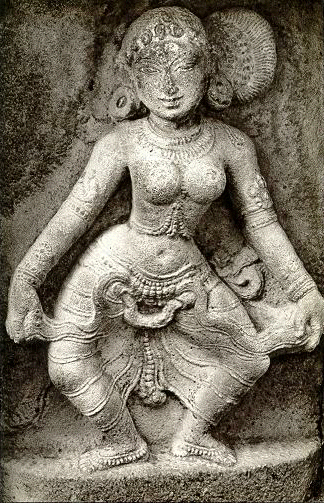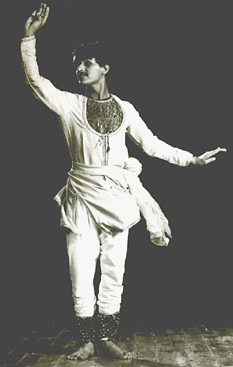When Many Feet Make Loud Work
BY: RACHAEL HOWARD

Dec 3, SAN FRANCISCO, CALIFORNIA (NEW YORK TIMES) —
In most classical dance forms, effortlessness is an illusion, but in Indian Kathak it’s a force of will. That seemed the only way to explain the strained, determined smiles of a dozen women as they stamped and spun, tunics soaked with sweat and feet laden with five pounds of bells. At the front of the room Chitresh Das, the wild-eyed man who styles himself the George Balanchine of Kathak, slapped the tabla. “Taka dimi, taka dimi,” he shouted, chanting the beat. “Come on, I’m not hearing you. Louder!”
The rhythms rushed to an ecstatic explosion, and as the climax faded, Mr. Das’s face softened from the stern authority of Shiva to the mischievous confidence of Krishna, two Hindu deities he has portrayed countless times in six decades devoted to his ancient art.
“This is a recent thing in Kathak history,” he said, nodding proudly at the panting women in the cultural center where he gives his classes. “You see, because our form is classical doesn’t mean it doesn’t evolve.”
He was talking about his proudest achievement, Kathak Yoga: not the latest exercise craze, but rather a practice of movement meditation that updates one of India’s eight official classical dance forms, as deemed by the Sangeet Natak Akademi, India’s rough equivalent to the National Endowment for the the Arts.
Traditionally Kathak has been passed on through intensive study with a single teacher and performed in long solo improvisations that can last for hours at a stretch. But this more modern form features dancers continually reciting the basic rhythm while embellishing upon it with their feet.
Kathak, a northern Indian dance tradition and the country’s only classical dance form with both Muslim and Hindu influences, has undergone many evolutions in the last 20 years. These include Martha Graham-like abstractions, Bollywood-esque spectacles, even a lavish Kathak “Romeo and Juliet.” Akram Khan, who melds Kathak and contemporary dance, is one of the hottest choreographers in Britain, and fusion is a buzzword among Kathak practitioners in India.
That’s a far cry from the intimate performances of kathakas (the word literally means storytellers) who delighted 17th- and 18th-century Mughal rulers by acting out Hindu tales and riffing with virtuoso tabla players.
Not all these developments please Mr. Das, who is bringing together the leading forces in Kathak this week in San Francisco. Hundreds of disciples, scholars and gurus — dozens of them from India — will converge on the Yerba Buena Center for the Arts for Kathak at the Crossroads, a three-day festival of performances and discussion.
It’s just one reflection of an international appetite for Kathak, bolstered by mass emigration from India and by a Western interest in star musicians like the sitarist Ravi Shankar and the tabla player Zakir Hussain. Recently the Chicago-based Natya Dance Theater’s Dance India festival featured Kathak prominently, and next month Birju Maharaj, the most famous exponent of the Lucknow gharana, one of Kathak’s two dominant stylistic schools, will dance at Symphony Space in Manhattan as part of the World Music Institute’s Festival of India. Kathak academies are becoming as plentiful in India as ballet studios in America, and workshops with big-name gurus are in demand in Germany, Australia and beyond.
The shift from the solo form to the group spectacle started in the 1960’s, when a dancer named Kumudini Lakhia began to feel “claustrophobic,” she said, in her guru-shishya parampara, the close spiritual relationship between master and student. So she began analyzing the geometries of the steps and postures, staging highly abstract dances.
“I said, ‘Let’s get rid of the stories,’ ” she recalled in an interview from Chicago, where she was attending Dance India. “Let’s name our priority. It is the body.”
Around the same time Birju Maharaj, born into one of India’s most famous families of dancers, started arranging group works. “The Krishna did not dance alone,” Mr. Maharaj, now 68 and still performing, reasoned recently from his dance center in New Delhi. “My uncle looked at my group work and said: ‘What is this? Why?’ I said, ‘The times have changed.’ ”
Since the days of Ms. Lakhia and Mr. Maharaj’s early experiments, Kathak’s fortunes have risen considerably, both in the United States and at home. But popularity brings perils. Mr. Das, 61, is concerned that the traditional hours-long solo will die; that young dancers now expect to take the stage instantly in huge group performances rather than study with a single teacher for decades, as he did; that the nuances of abhinaya, the delicate gestures and facial expressions that complement Kathak’s powerful footwork, could be lost forever.
And yet most of his worries pertain to a single Western idea. “Everyone is into choreography these days,” he said, rather than improvisation. His disciples listened and nodded intently. “That is where we draw the line,” he said.
It is interesting that Mr. Das would be the one to choose to draw it. He came to the San Francisco Bay Area 35 years ago with the dream of teaching Kathak to American women, and performing with the greats of American dance. Gregory Hines declined, and Mikhail Baryshnikov has yet to get back to him. But in recent years Mr. Das, who went to jazz clubs as a teenager in India, has jammed with a jazz band alongside the tap star Jason Samuels Smith. He has admired Western choreography since meeting the modern-dance luminary Pauline Koner in Calcutta as a boy; many years later in New York he also met Alwin Nikolais, the 20th-century avant-gardist.

So Mr. Das said he speaks from wide exposure when he judges that most contemporary Kathak choreography simply isn’t very good. “If one wants to choreograph in the Western sense, you have to understand the Western world,” he said. “And that’s concept-driven. Martha Graham, Merce Cunningham, etc. — they each had their concept. If the whole world wants to do that, they should study it deeply first.”
Ms. Lakhia shares some of those concerns. “I feel the younger artists are doing the group choreography because they feel they have to, for the grants and all that,” she said. “And I don’t think there are enough people who are passionate about Kathak.”
Meanwhile a new generation seems to be struggling to find its own position. Sandip Mallick’s group choreography has experimented with flamenco and was awarded a grant from the Indian government for a work that mixed in martial arts. Kathak at the Crossroads will provide him with a rare opportunity to perform a solo, one portraying not Hindu tales, but a more general struggle of the spirit.
Mr. Mallick, 32, sees his more conceptual solo as an ideal compromise. “Kathak is now so concept-heavy,” he said. “How can I save the purity of my form but pour it into a new frame?”
For Mr. Das, one way forward is Kathak Yoga, an innovation that Mr. Maharaj and Ms. Lakhia said they were not familiar with. But Mr. Das believes his training practice is paying off on new shores.
“At first the flower children, they were not interested in discipline,” he remembered of his early days in California around 1971. “They would come to class stoned and say, ‘Hi, Chitresh, can we do the Krishna dance?’ ” Now Mr. Das is sending his first finished disciples onto the stage, and his schools in San Francisco, Boston and Calcutta are packed.
Like most Kathak gurus Mr. Das says he is certain that his legacy will survive.
“I will make sure that Kathak lasts because I’ve already done the work of Kathak Yoga,” he said as his students discreetly wiped the sweat from their faces. “And that will last. That will last forever.”
Copyright 2006 The New York Times Company
